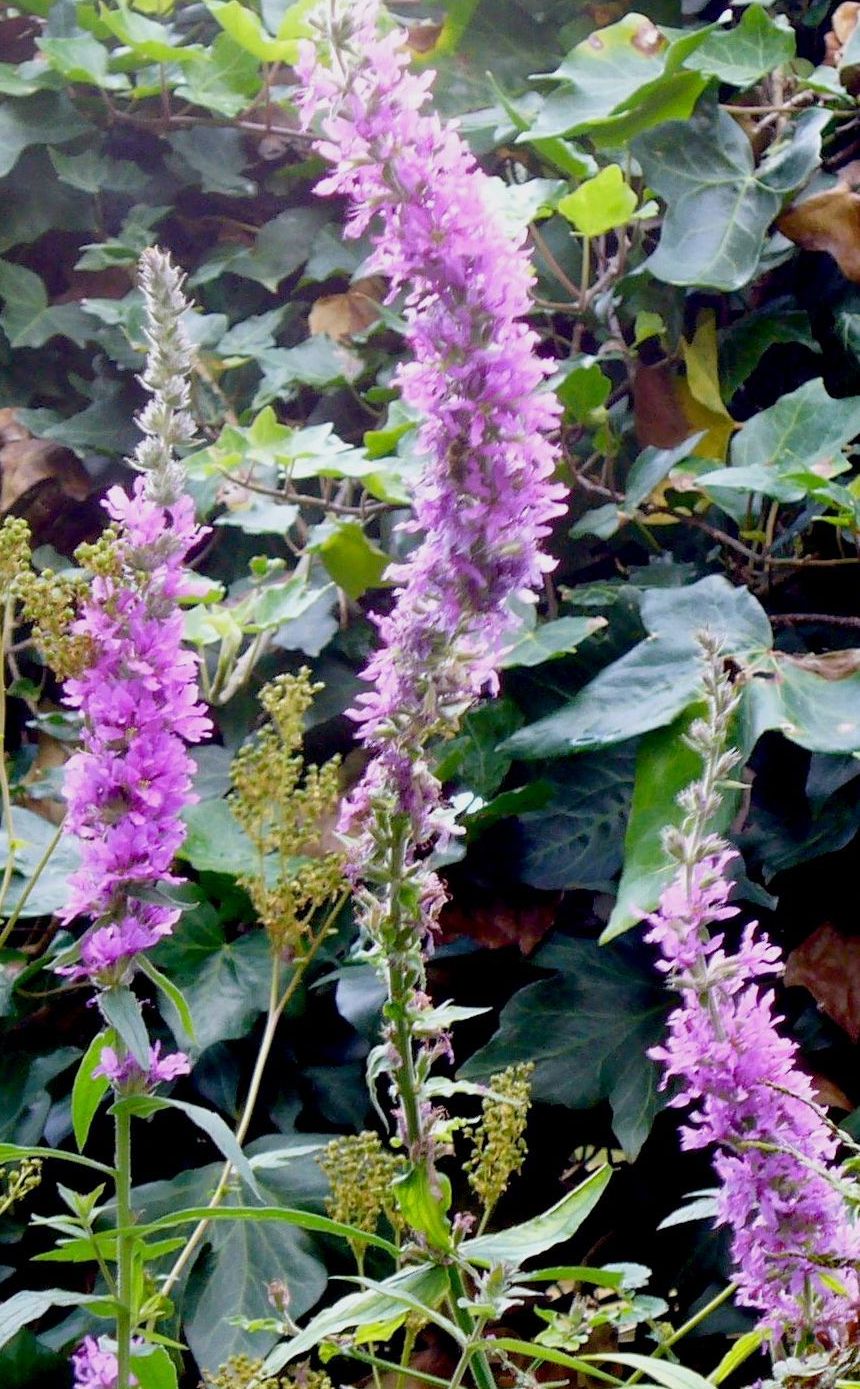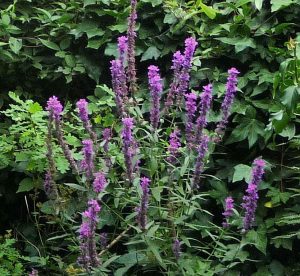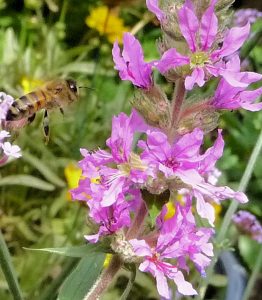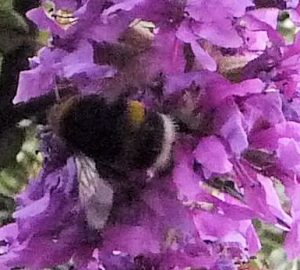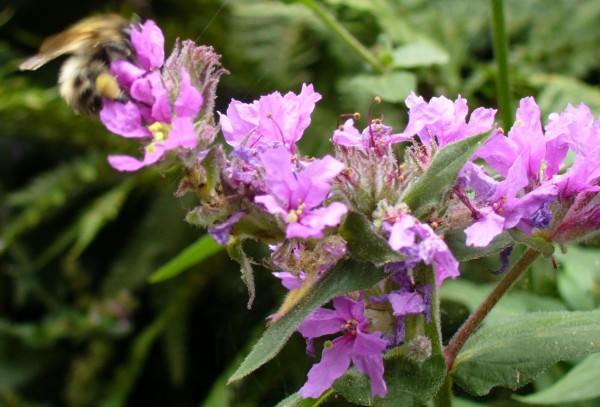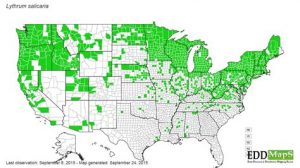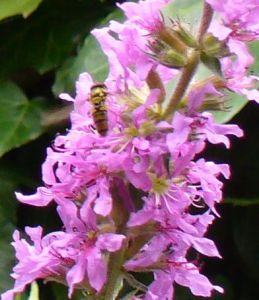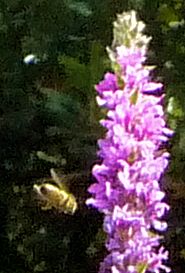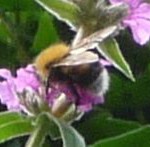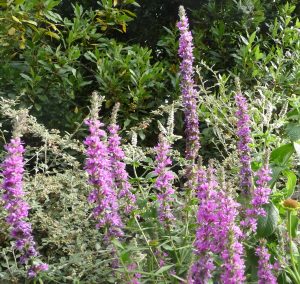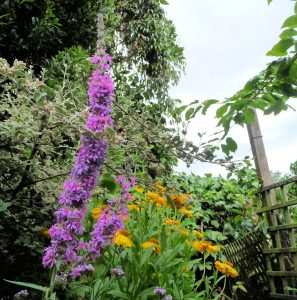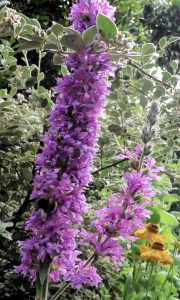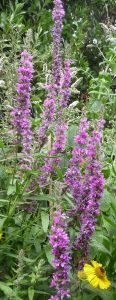PURPLE LOOSESTRIFE (Lythrum salicaria)
Europe, Russia, Japan, Manchuria, China, Asia, India
A perennial wildflower of wet ground, Purple-Loosestrife grows at the edges of ponds, riverbanks, reedbeds & ditches. In suitably moist conditions it can reach a meter and a half in height. Tall stems with dark green lance- shaped leaves are topped with spires of MAGENTA-PURPLE flowers which bloom from June to August.
Boggy, damp clay or loam soil suit it best. Feet in the wet, the rest of the plant in full sun. Divide clumps every 3 to 5 yrs to avoid congestion.
Bees’ Favourite.
Lythrum salicaria is loved by Brimstone Butterflies, Bumblebees & other long-tongued insects, including the Emperor Moth, the Pug Moth, the Elephant Hawkmoth & the Powdered Quaker Moth.
http://www.seedaholic.com/lythrum-salicaria-purple-loosestrife.html
Other names: Arroyuela, Black Blood, Blooming Sally, Bouquet-violet, Braune weiderich, Emmets Stalk, Flowering Sally, Foxtail, Grass Polly, Herbe aux Coliques, Herb Twopence, Long Purples, Loosestrife, Lysimaque rouge, Lythrum, Milk Willow-Herb, Partyke, Purplegrass, Purple Lythrum, Purple Willow-Herb, Rainbow Weed, Red Sally, Rose Loosestrife, Rosy-strife, Rosy Strip, Rother weiderich, Sage-willow, Salicaire, Salicaire Commune, Salicaire Officinale, Salicaria, Soldiers, Spiked Loosestrife, Spiked soldiers, Spiked willow herb, Willowweed, Willow Sage, Willow Strife. Espernto: Katvosto granda, Litrumo granda, Salikario. Estonian: Kukesaba, harilik Faroese. Finnish: Rantakukka, yleinen. French: Lysimachie rouge, salicaire. German: Heinrich, stolzer Weiderich, blut- Weiderich, gemeiner. Hungarian: Reti fuzeny, Irish (Gaelic): Earball caitin. Italian: Canestrell, Riparella, Salcerella, Salicaria, Spergola, Verga Rossa; Latvian: Roze, kazu,
Invasive when introduced elsewhere
Lythrum salicaria is an invasive species in New Zealand & the US, where it has spread to every state except Florida. http://refugeassociation.org/advocacy/refuge-issues/invasive-species/purple-loosestrife/
Purple Loosestrife was accidentally introduced into North America in the 1800s, in ship’s ballast or as ornamentals. It has since proved invasive. In wetlands of the midwest & northeastern USA it has taken over, swamping native plants.
“Lythrum salicaria is an outlaw. It is considered a noxious, invasive weed throughout the United States. It is illegal to import, sell, offer for sale, or distribute the seeds or the plants of purple loosestrife in any form.” www.plant-care.com › lythrum.html
Purple Loosestrife in Highbury
We had no reedbed or pond to offer our Purple Loosestrife when we brought it back from a wildflower sale at the Ecology Centre. In the shade of the neighbour’s fence we laid down plastic sheeting to hold moisture, & made certain the soil we put on top of it was kept well watered. The plant has been happy enough with these conditions to regrow every season, welcomed by ourselves & our local bees. Lythrum salicaria has been, here in North London, free from pests or diseases. A problem-free wildflower.
*****
For years, this plant did well in the damp shade of the Fern Bed. Last season however, as other plants shaded out its sunlight, it never flowered well. It was dug up and replanted into a container, a metre out of the shade. Given more sun, a much happier Lythrum salicaria is now bringing in the bees as ever.
